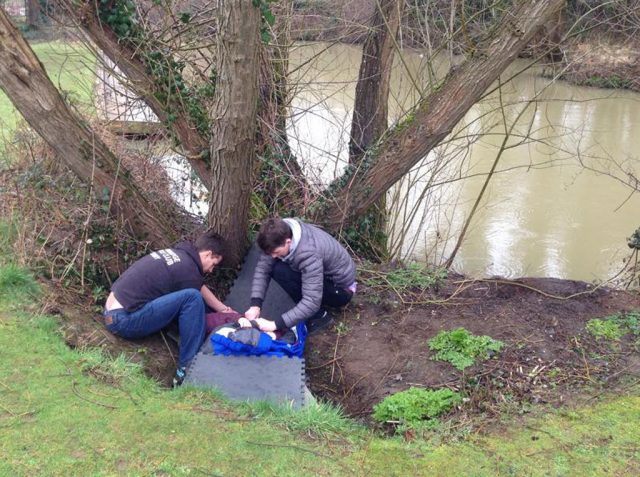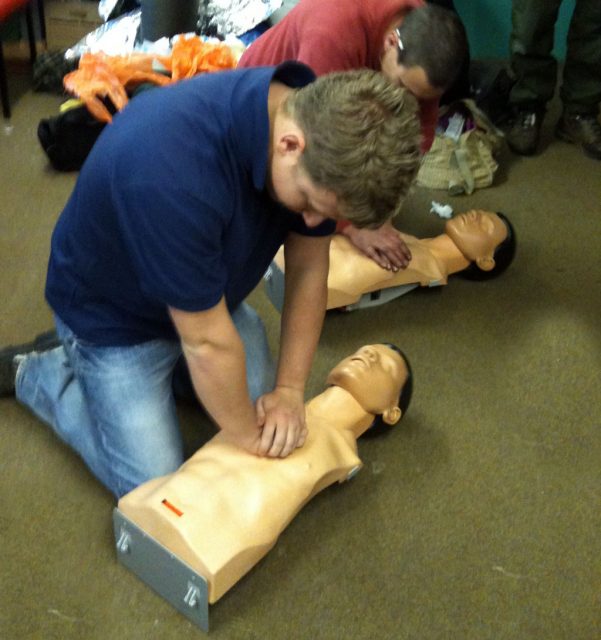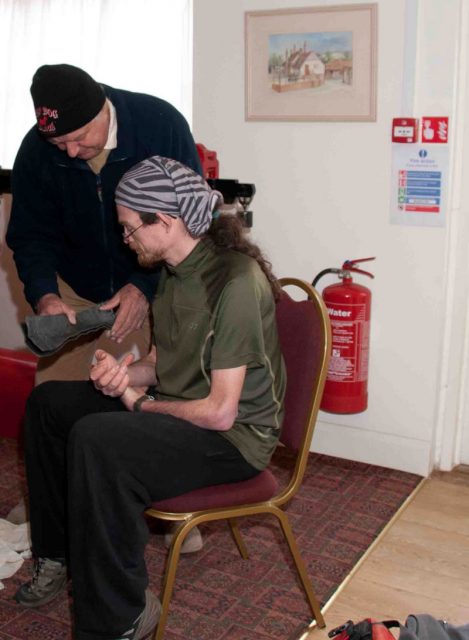Basic First Aid: Something we all really should know
Basic First Aid
A great first aid article from the British site Bushcraft UK
Bushcraft is generally a low risk activity and most people enjoy days out in the countryside without incident. It is wise though to carry a small first aid kit and have a little knowledge of treating common minor injuries. This article is not intended to be a definitive guide on first aid but will give you a few ideas on what you should consider and how to respond.
We all carry out risk assessments in our daily activities. When crossing the road, lifting a hot pan during cooking etc. Bushcraft and wilderness travel is the same, if you are practicing skills near to your home and an ambulance is a quick phone call away then a small pocket first aid kit and a little knowledge is all you need. However if you are venturing into the mountains and more remote locations it would be wise to seek further training and carry a more comprehensive kit.
Why learn First Aid?
First aid is an important skill. By performing a few simple techniques it may be possible to save a life until medical help arrives. It can be a very lonely place when you’re in an emergency and must react effectively in a timely fashion. A little knowledge and practice will give you some confidence and peace of mind.
Summoning Help.
Even in the UK mobile phones may not always have a signal and modern smart phones often need regular recharging. It would be wise to consider how you are going to be able to seek help in an emergency.
- Is there a signal?
- Where is the nearest landline?
- Do I need to carry a spare battery?
- Where am I?
Knowing your location may seem obvious but when calling for an ambulance it is vital to know your location to get help as quickly as possible. Remember that an ambulance may have to approach your location from a different access point if you are in the woods.

Unconscious Non Breathing Casualty.
Check the casualty is breathing and responsive by gently shaking their shoulder and speaking loudly. Tilt the head, so that the chin is pointing upwards. Do this by placing the fingertips under the jaw, then lift gently while pressing down softly on the person’s forehead. This is done to make sure the tongue is not blocking the airway. Listen closely with your ear to close their mouth looking at the chest. If they are not breathing normally call an ambulance and start chest compressions.
Basic Life Support.
Keep it simple. Try not to panic. Place your hands on the centre of the casualty’s chest and press down with your arms straight 3-5cm or a third of their body. At a rate of 100 -120 chest compressions a minute. Continue until help arrives or you are no longer able to continue.If you have some further training then consider rescue breaths at a ratio of 30:2.

Rescue Breaths.
Rescue breathing is difficult to perform in an emergency without regular practice. On smaller casualties it is often easier to fully cover the mouth and nose. On adults you can try mouth to mouth or mouth to nose. Tilt the head back as before to ensure you have a clear airway and breath normally for the casualty. Watch for their chest rising as you are breathing. You are not trying to blow up a balloon just topping up their oxygen levels to keep their vital organs alive. After 2 breaths return to 30 chest compressions. This is physically very demanding.
Bleeding.
Remember; Red stuff on the inside Good. Red stuff on the outside Bad.
- Wear Gloves
- Sit the casualty down and raise the limb.
- Apply direct pressure to the wound with whatever you have available.
- Assess the severity of the wound.
- Apply a hypoallergenic plaster if the wound is small.
- Consider steri strips to close the wound and bandage.
- If in doubt seek medical attention.
Shock.
True Shock is a life threatening condition and needs to be recognised quickly and treated.Shock is defined as the inability of the body to transport oxygen around the body and has many causes from blood loss to stroke.
Signs and Symptoms.
The causality may be pale with sweaty cold and clammy skin. They are likely to feel faint and dizzy with a rapid weak pulse with weak breathing. Eventually they will become unconscious and go into a coma.
Treatment.
- Keep the casualty warm. Insulate them from the ground and lie them down.
- Cover with a spare jacket or blanket etc.
- Raise their legs by placing them on a rucksack for example.
- If the casualty has an injured leg only raise the good leg.
- Monitor and be prepared for CPR.
Burns.
Even minor burns can be a serious problem in the outdoors with the heightened risk of infection,Cool the burn as soon as possible with any drinking quality water. Cool for a minimum of 10 minutes.If the burn is more than 1-2% of the patient’s body medical advice should be sought.
- Do not burst any blisters
- Do not remove clothing.
- Do not apply any creams or oils.
- Use only burns dressing or lotions such as burnshield.
- Remove any jewellery.
- Keep the casualty calm and offer lots of reassurance.
- Apply a non adhesive dressing.
- Burns to the face should be treated seriously and immediate medical help sought.
Bites and Stings.
Fortunately in the UK we have only one species of venomous snake the Adder. The Adder is not aggressive and if left alone most people are unlikely to have any problems with snakes. In the summer they can often be found on forest pathways sunning themselves sleeping. If you step on one it will be upset and likely defend itself. Adder venom is not particularly potent as Vipers go. A healthy adult should not have any major medical problems resulting from an adder bite. However some people may have an allergic reaction to the venom and those with pre-existing medical conditions can become seriously ill. If you suspect you have been bitten, stop, keep calm and take a photo on your phone of the snake for identification. Apply a bandage above and below the wound. Avoid panic. Seek Medical Advice.
Bees and Wasps.Try to avoid conflict with wasps by maintaining good camp hygiene. If you leave food available you will attract them. Avoid big movements that may provoke a sting. Keep calm and gentle brush a wasp away. If you are stung it can be very painful and the limb may well swell and become unusable.Every year people in the UK die as a result of an allergic reaction to Bee and Wasp stings. If you know you have an allergy to stings ensure you keep your epipen near to hand and have a plan in the event of a reaction.If stung try and keep the casualty calm and sit them down.Carefully remove any sting with a pair of tweezers taking care not to inject more venom into the skin. Cool the wound with a cold pack to reduce swelling.

Conclusion:
The great outdoors is a wonderful playground and offers lots of health benefits both physically and mentally for those venturing out. Modern life provides little time for slowing down and enjoying the simple pleasures of watching wildlife and enjoying nature’s beauty. A little common sense and some planning should enable you to make the most of the woods without incident. A basic knowledge of first aid is an important life skill and all should be encouraged to learn the basics. If venturing further afield or leading others then one should consider attending a reputable first aid course run by a provider with experience of first aid in a more remote setting. Also a first aid kit is only useful if you have it with you so get into the habit of carrying a small kit with you whenever you venture out. A First Aid Kit must be carried when you intend using sharps.
Basic First Aid Kit.
A simple first aid kit can be purchased from a wide variety of locations from the internet to supermarkets. Beware the temptation to purchase more than you need and more equipment than you are trained to use. I use a simple small Tupperware box to keep my kit dry, stored in a side pouch of my pack.
Full contents include:
- 1 x medium ambulance dressing.
- 1 x large ambulance dressing.
- 4 x small sterile dressings.
- 2 x medium sterile dressings.
- 2 x large sterile dressings.
- 2 x triangular bandages.
- 20 x fabric plasters.
- 2 x prs Nitrile exam gloves.
- 1 x 7.5cm crepe bandage.
- 1 x Steristrips (3).
- 8 x antiseptic wipes.
- 1 x resuscitation shield.
- 1 x pr EMT shears.
